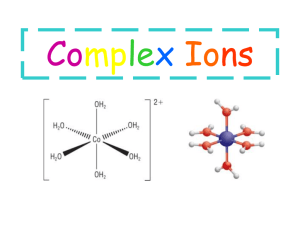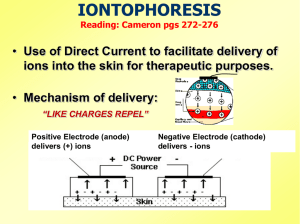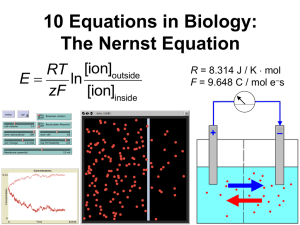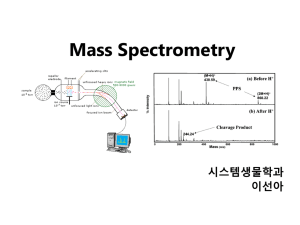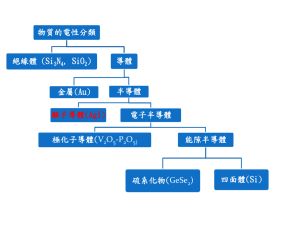Z” Z
advertisement
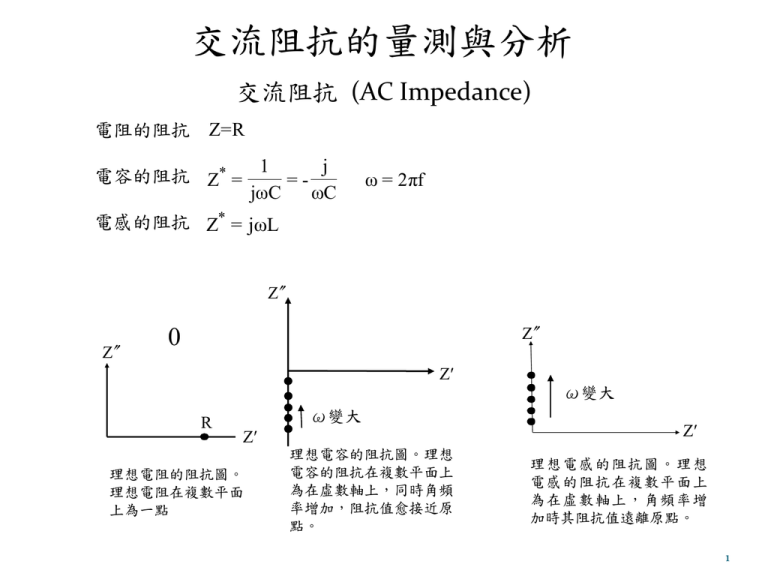
交流阻抗的量測與分析 交流阻抗 (AC Impedance) 電阻的阻抗 Z=R 1 j =jωC ωC 電容的阻抗 Z* = ω = 2 πf 電感的阻抗 Z* = jωL Z〞 Z〞 Z〞 0 Z′ ω變大 R ω變大 Z′ 理想電阻的阻抗圖。 理想電阻在複數平面 上為一點 理想電容的阻抗圖。理想 電容的阻抗在複數平面上 為在虛數軸上,同時角頻 率增加,阻抗值愈接近原 點。 Z′ 理想電感的阻抗圖。理想 電感的阻抗在複數平面上 為在虛數軸上,角頻率增 加時其阻抗值遠離原點。 1 R C RC串聯等效電路 - ω RC串聯電路阻抗圖 2 R 電解質樣品夾於兩電極片中間 如同電容及電阻並聯 C × -Z” R ωRC=1 R/2 ω=0 ω= ∞ R/2 R Z’ 電容與電阻並聯之理想交流阻抗分析圖 3 高溫探頭結構示意圖 (1)白金線:連接電極片與接頭; (2)樣品; (3)氧化鋁墊片; (4)白金電極片; (5)熱電偶; (6)外殼; (7)彈簧; (8)通氣管1; (9)連接交流阻抗分析儀; (10)通氣管2。 4 frequency Delay Time Measurement Time t 0 交流阻抗分析儀量測不同頻率的阻抗過程 5 阻抗Z*數據表示方式 jθ Z * = Z' + jZ" = Ze 10 10 -Z"(M) 10 -Z"(M) Z'(M) 20 R=1.5 ×107 Ω, C= 1.4 ×10-12 f 8 6 4 2 3 10 4 10 5 10 6 10 7 10 0 2 10 -(deg) Z(M) 20 10 3 10 4 10 5 10 6 10 frequency(Hz) 4 3 10 4 10 5 10 6 10 0 7 10 0 5 7 10 100 100 80 80 60 40 20 0 2 10 10 15 20 Z'(M) frequency(Hz) frequency (Hz) 0 2 10 6 2 -(deg) 0 2 10 8 60 40 20 3 10 4 10 5 10 6 10 frequency(Hz) 7 10 0 0.1 1 10 Z'(M) 6 在交流阻抗的數據分析上,有各種複數形式可以分析, 分別是阻抗Z、導納Y(admittance),也可以採用複數形式 的介電常數ε(dielectric constant)與電模係數M(electric modulus),它們彼此的關係如下表 Z、Y、M、ε的關係 M Z Y ε M M j wC0Z j wC0Y-1 ε-1 Z (jw C0)-1M Z Y-1 (jw C0)-1ε-1 Y jw C0M-1 Z-1 Y jw C0ε (j wC0)-1Y ε ε C0 0 A d M-1 (j wC0)-1 Z-1 ,d為樣品厚度,A為面積, 為自由空間中的介電係數8.85× F/cm。 7 將Z*轉換成M*分析數據 M * = jωC 0 Z * = M' + jM" M' = -2 πfε o A A Z" , M" = 2 πfεo Z ' d d R=1.5 ×107 Ω, C= 1.4 ×10-12 f , A=1 ×1cm2, d=0.1cm 0.003 0.006 0.006 0.003 M" 0.004 M" M' 0.002 0.001 0.002 0.000 0.000 2 10 3 10 4 10 5 10 frequency(Hz) 6 10 7 10 2 10 3 10 4 10 5 10 frequency(Hz) 6 10 7 10 0.000 0.000 0.002 0.004 0.006 M' 8 0.25Na2O-0.75B2O3 3 5 60 160 C 4 o 1 Z"() 260 C Z"(K) 2 40 360oC 3 2 20 1 0 0 1 2 3 0 0 20 Z'(M ) 40 60 0 Z(K ) 1 2 3 4 5 Z( ) Jonscher relation -3 10 -4 10 -1 0 (-cm) Z"(M) o -5 10 -6 10 -7 10 2 10 3 10 4 10 5 10 frequency(Hz) 6 10 7 10 9 混合鹼金屬效應簡介 當玻璃結構中,只含有一種鹼金屬離子時,其某些性質如導電度會和鹼金 屬的含量成線性關係。然而玻璃中含有兩種鹼金屬時,直觀上導電度應該 是兩種離子導電度的線性相加,也就是σ=nAσA+ nBσB,nA 、σA與nB、σB分別 為兩種鹼金屬的濃度與導電度。但實際上並沒有呈現出兩種鹼金屬線性疊 加,而是出現非線性變化。如右下圖所示,Li和Cs為玻璃中含兩種不同的 鹼金屬離子,當離子含量固定時,導電度隨著Li與Cs兩種離子含量的比例 變化先下降再升高。這種非線性關係我們稱為「混和鹼金屬效應」(Mixed Alkali Effect,MAE)。 (xLi2O-(20-x)Cs2O)-15Ga2O3-65GeO2 glasses (-cm) 540 0 1.2 10 -3 o Tg( C) 520 10 E(eV) 560 -1 (a) 0.8 500 10 480 -6 0.4 460 0 5 10 x(mol%) (b) 15 20 10 -9 0 5 10 15 20 x(mol%) 10 關於鹼金屬效應現象的解釋有不同理論,Bounde提出Dynamic Structure Model(DSM),其內容是說:離子在玻璃網絡內,其所在的位 置和周圍的環境可看成一個site,當離子受到外加電場而離開時,原先 離子所在的site仍保有原來的特性,如果是另一個相同種類的離子則可 以很容易進入此site,但若是不同種類的離子便很難進入site。由DSM 模型可知,不同種類的離子會形成不同的site,且會阻礙彼此的傳導, 因此混和鹼金屬的玻璃導電度下降,而且當兩者比例相同時,互相阻 礙的程度最大,所以導電度最低。 Ngai提出與DSM相似的耦合理論(coupling model)。當第二種鹼金屬 離子加入時,因為鹼金屬之間的耦合作用,會使在第二種鹼金屬附近 的鹼金屬離子變為較難移動,因此導電度變低。Ngai的耦合理論後面 還會詳細說明。 11 -35 實際量測之數據須考慮電極的效應 Z"(k) -30 -25 -20 樣品離子傳導 -15 電極效應 -10 -5 0 0 10 20 30 40 50 60 70 80 90 Z'(k) 電極效應 玻璃離子傳導 12 實際上交流阻抗的量測數據所畫的Cole-Cole Plot很少是標準的半圓圖形, 大部分會偏離半圓的圖形。由於玻璃是長程無序的固態物質,因此假設玻璃 中離子的鬆弛時間為一分布函數,不是一個單一數值也是合理的假設。 如前所述,一並聯的RC線路,僅有一鬆弛時間0(=RC),則離子的衰退函 數(Decay function)為指數函數 如果鬆弛時間為一分布函數,則阻抗由 變為 其中G()為鬆弛時間的分布函數。而衰退函數的數學形式為 13 g()為Moynihan所用之鬆弛時間分布函數, 但我們無法由上式得到g()的分析解,因此Moynihan使用最小平方法得到 g()的級數解。也就是 其gi是與0的函數,i是0的整數倍。函數exp(-t/τo)β稱為KWW函數, τo為特徵鬆弛時間,在耦合模型中, β稱去耦合參數(β=1-n ,n稱耦合 參數,表示離子與離子,或離子與結構鬆弛間的耦合程度) 。一般使 用複數非線性最小平方法(CNLS)來擬合實驗數據與所選用的模型線路 。 14 ZCPE稱為constant phase element代表電極的接觸面不平滑, ZGFW而稱為Generalized Finite Warburg Element,代表有限空間內的擴散, ZKWW為使用KWW衰退函數的離子運動的阻抗。 -35 Z"(k) -30 -25 -20 -15 -10 -5 0 0 10 20 30 40 50 60 70 80 90 Z'(k) 15 15 20 10 5 Z'(K) Z'(K) Z"(k) 10 5 10 0 0 0 10 20 Z'(K) 30 0 0 20 40 Z'(K) 60 0 20 40 60 Z'(K) 15 複數非線性最小平方法原理 CNLS的基本方法為找出一組參數使理論計算值與量測值間的差值的平 方合為最小。如果在角頻率wi量測值為Zi*(ωi),而等效電路計算之值為 (wi, p),其中p(=1, 2, …n)為等效電路所使用的參數。則殘差為 CNLS程式中所需要計算的就是改變參數使下列級數的合為最小, ' 其中ν i、ν"i為權重,等效電路計算之值為 、 。N為所使用不同角頻率 的數目,也就是量測時使用不同角頻率的數據。 16 Ngai之耦合模型 Ngai利用耦合模型推導出KWW衰退函數。Ngai假設離子移動時的躍遷率與時間有 關,可表示成下列式子: W(t)= 其中ωC為角頻率其值介於1011~1012 rad/s,當躍遷開始時的初期,在短時間裡(ωCt<1) W=Wo為常數與時間無關,但此躍遷是因溫度激發,因此 Ea稱為primitive energy barrier。因為耦合作用,當離子離開最初的位能障後,躍遷 率就與時間有關,因此當ωCt<1時,W=Wo(ωCt)-n變為時間的函數。其中n為耦合參 數(coupling parameter),其值介於0~1表示離子與離子,或離子與結構鬆弛(structural relaxation)間的耦合作用大小。當離子足以跳出初始的位能井之後,便會受到其他 離子的影響。因此時衰退函數φ (t)可表示成以下關係式 φ(t)可寫成下式: f 17 其中τo是特徵鬆弛時間,且 推導出的衰退函數與 KWW函數 形式一致,且1-n=β, β稱為去耦合 參數(decoupling parameter)。 在分析阻抗有關之量測數據時,有人從鬆弛時間分布函數著手,因此就有許多 不同的鬆弛時間分布函數被提出,例如Lognormal、Cole-Cole function、ColeDavidson function等。但這些函數與數據間的擬合度都不是很理想。因此 Moynihan由衰退函數著手,他使用stretch指數函數為衰退函數,此衰退函數一 般稱為KWW函數,而其他人提出之鬆弛時間分布函數僅為擬合用之現象方程 式,無法經由微觀模型推導而得之。而Ngai利用耦合模型推導出KWW衰退函 數,這也是KWW函數被廣泛使用之原因。 Lognormal g ( τ) = Cole - Cole g( τ) = b τ exp[ -b2 (ln ) 2 ] π τo 1 sin απ 2 π [cosh(1 - α)log( τ/τo )] - cosαπ sin πβ τ β ( ) for τ < τ o π τo - τ = 0 for τ > τ o Cole - Davidson g( τ) = 18 Lognormal KWW =0.375 =0.6 -10 -7 10 10 -1 2 10 -3 10 0 10 -7 10 -4 10 =0.55 =0.95 -1 10 2 10 5 10 8 10 / o Cole - Cole g( τ) = 10 / o =0.25 =0.5 -10 3 10 / o 10 b τ exp[ -b2 (ln ) 2 ] π τo b=0.2 b=0.5 -4 10 g ( τ) = 1 sin απ 2 π [cosh(1 - α)log( τ/τo )] - cosαπ -3 0 10 10 / o sin πβ τ β ( ) for τ < τ o π τo - τ = 0 for τ > τ o Cole - Davidson g( τ) = 19 耦合模型的應用 鋰離子在L2O-B2O3, L2O-SiO2, L2O-B2O3-SiO2, L2O-B2O3-Al2O3 耦合參數的比較 0.9 LB LBA LBS LS 0.6 n 0.3 structural-relaxation is predominate at high temperature ion–ion coupling is predominate at low tempertaure 0.0 0.5 0.6 0.7 T/Tg 0.8 0.9 20 耦合模型的應用 20(Li2O-Cs2O)-15Ga2O3-65GeO2 glasses Mixed alkali effect 21 The coupling model attributes the mixed alkali effect to mutual interception of jump paths of both kinds of mobile ions . Various experimental techniques have shown that there is a large local site energy difference between two different alkali ions in the mixed alkali glasses. Therefore, jumping of an alkali ion to the sites for a different alkali ion cannot occur. It follows that there are fewer sites for ionic motion of the host alkali species when different alkali ion is introduced. This will immobilize both different alkali ions. The immobilization effect can propagate to the second nearest neighbor host ions and beyond, resulting in a decrease of mobility of a large number of host ions and the decrease of conductivity of the sample. This blocking will reduce the number of effective mobile ions as well as increase the distance between mobile alkali ions. Hence, when different alkali ion is introduced, coupling interaction between mobile ions will be decreased. 22 Figure (c) shows a curve overlapping for samples Li8 at 360oC and Li20 at 150oC. The ion motion in the former sample is influenced most by the blocking effect, while there is no blocking effect for the latter one. According to the coupling model, sample influenced by the blocking effect has less effective mobile ions. Therefore, ions in sample Li8 need more thermal energy to have the same behavior as those in samples Li20 at low temperature. Also the width of the curve for Li8360oC is narrower than that for Li20–150oC. This indicates that the coupling interaction between ions in the former one is smaller than that in the latter one. This is consistence with the blocking effect proposed in the coupling model. 23 ion–ion coupling and the ion and structural-relaxation are both important ion–ion coupling is predominate 24 According to the blocking mechanism which is originated from ion–ion interaction, the coupling parameters are decreased with increasing amounts of second alkali ions and have a minimum n at an intermediate amount of second alkali ion. This figure shows that the variation of n with composition does not vary as expected. This may attribute to the coupling between ion and the structural-relaxation. The variation of n with lithium oxide fraction at nearly constantτ (2.5± 0.5× 10-5 s). The dashed curve is for eyes guidance. 25



